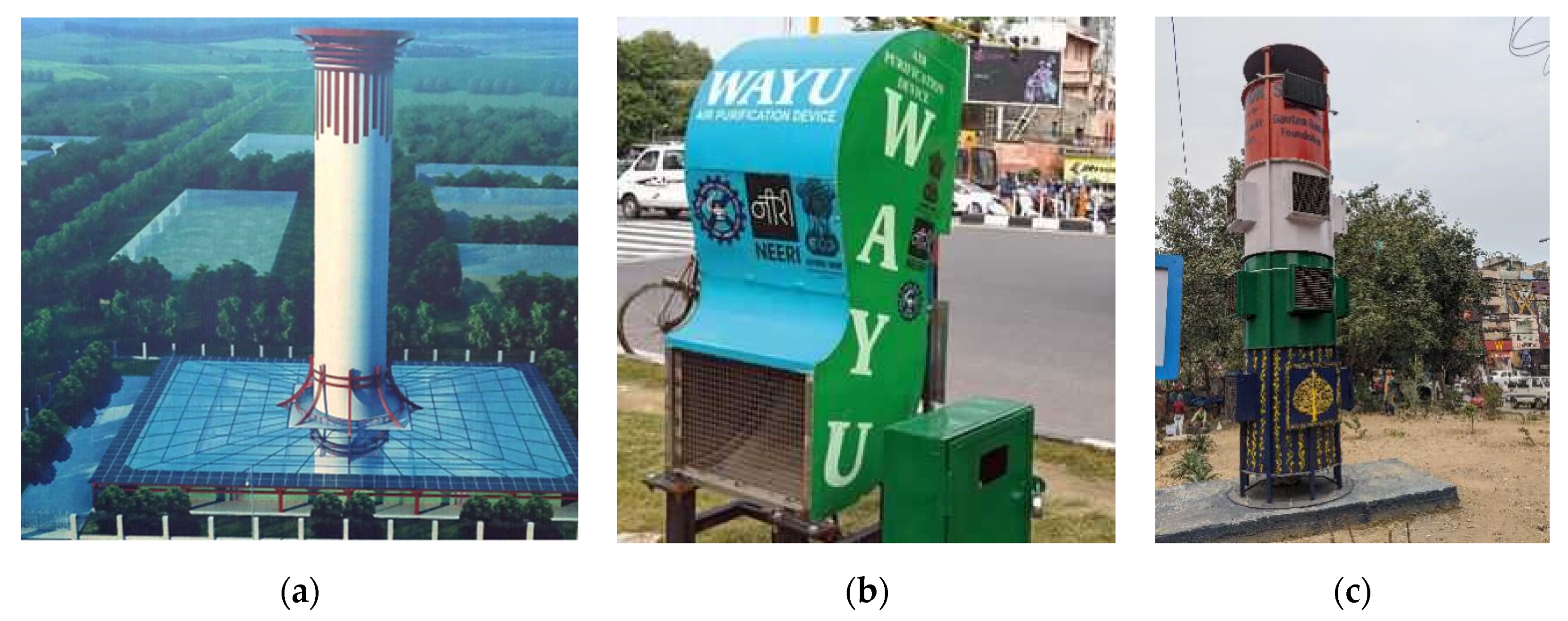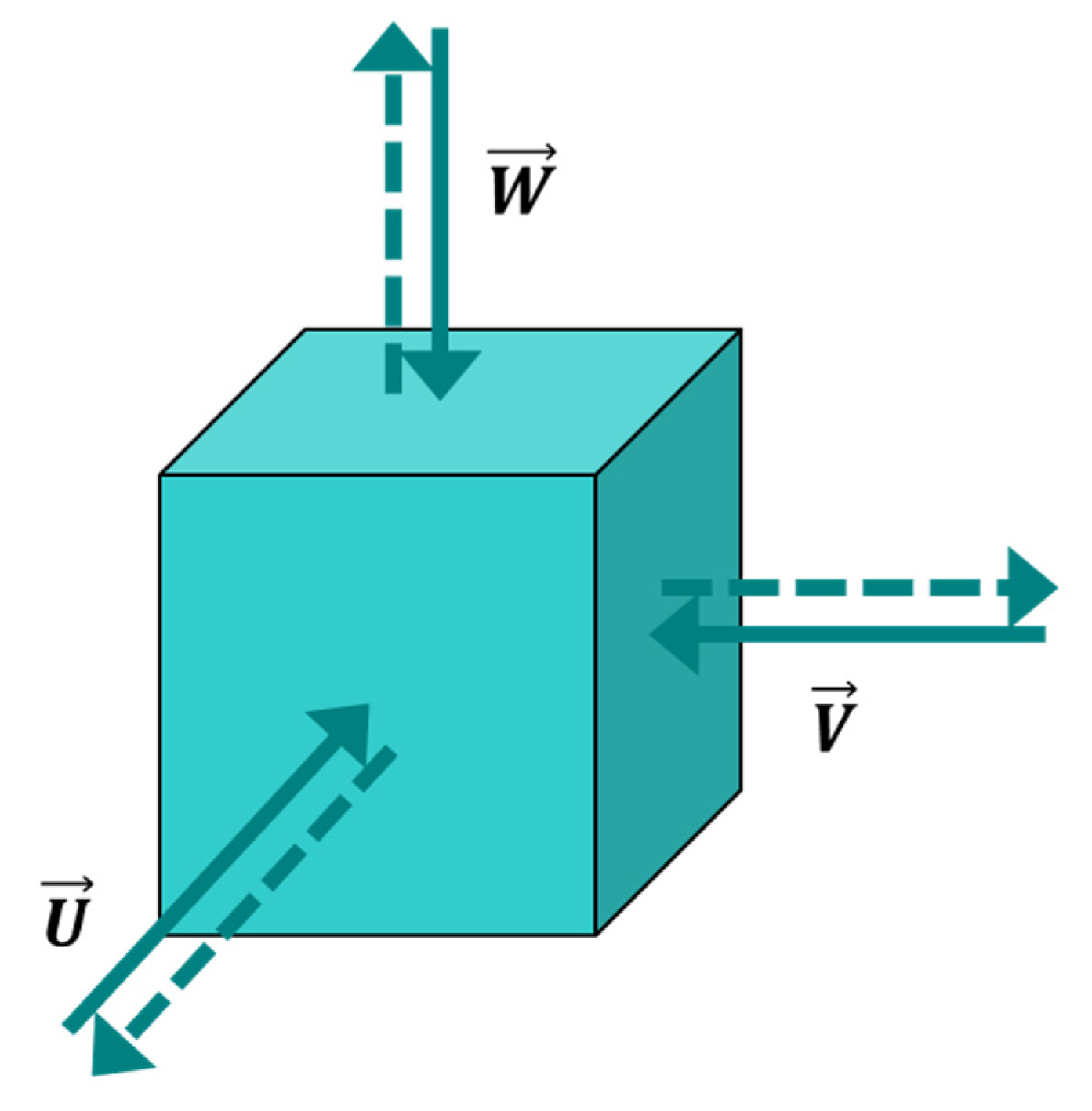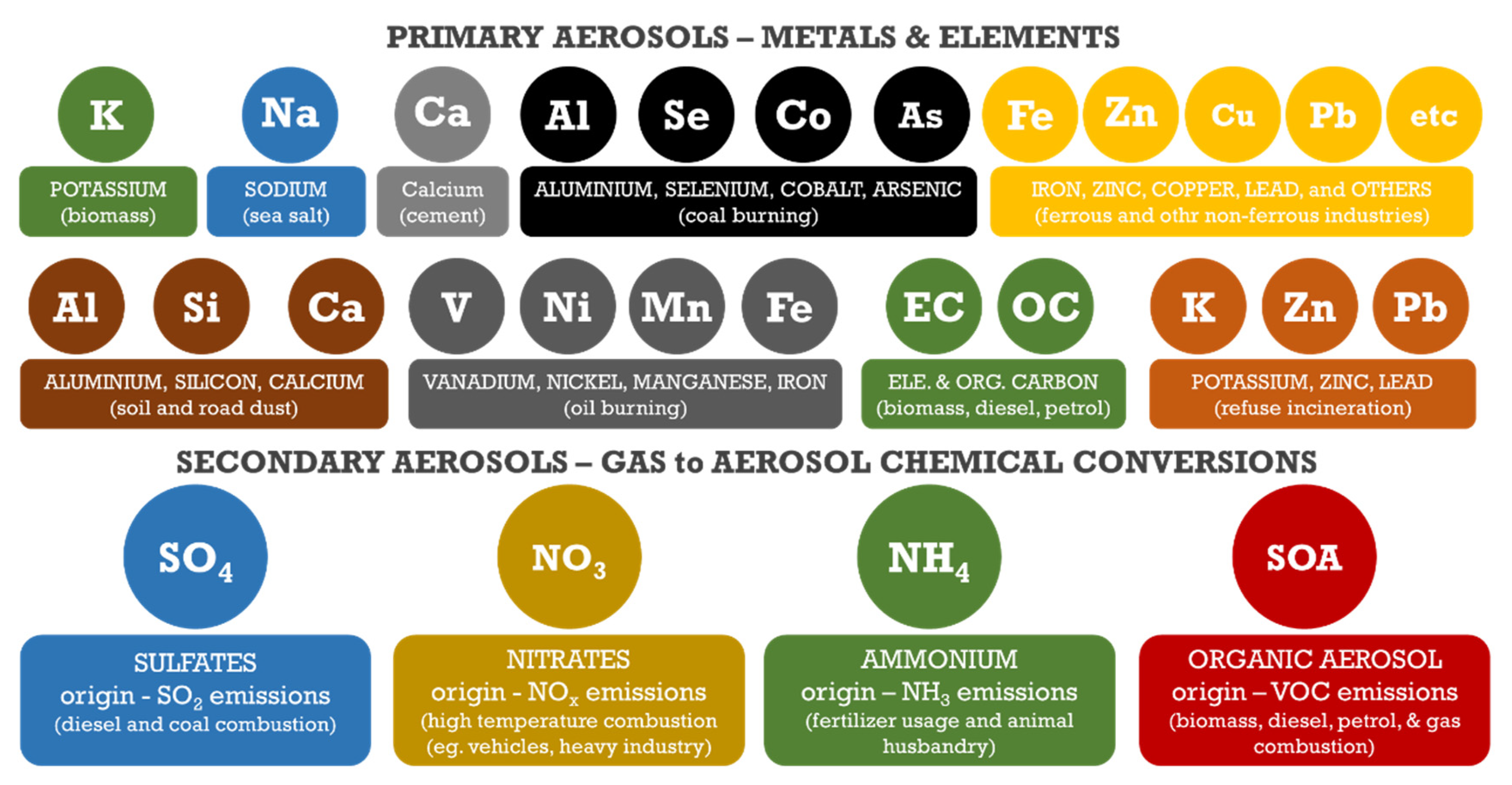Can We Vacuum Our Air Pollution Problem Using Smog Towers?
Abstract
1. Introduction
2. The Sciences
2.1. Mathematics
2.2. Physics
2.3. Chemistry
3. Do Smog Towers Work?
4. Taking a Long View on Air Quality Management
- In 1998, the Supreme Court ruled to convert public transport buses and para-transit vehicles to run on compressed natural gas (CNG). This was a public interest litigation, which also led to other emission control measures in Delhi [32,33]. CNG conversion was the most successful for the transport sector and, in the early 2000s, the city of Delhi witnessed a reduction in emissions and pollution. However, the scale of replacement has not been replicated in any other Indian city since, and the overall bus fleet composition in Delhi has remained the same irrespective of the growing demand [34].
- In 2015, three toddlers filed a public interest ligation in the Supreme Court of India, to request a full ban on the sale of fireworks. In an apparent victory for cleaner air, in November 2016, the Court ordered a complete ban on the sale of firecrackers in the NCR. What seemed to be a progressive measure was, however, annulled by a ‘temporary’ ruling, when the ban was lifted with the caveat that the ban will be reinstituted if there is evidence that fireworks are a major pollutant during the festive season.
- In 2018, the Supreme Court ruled in favour of the introduction of BS-VI standard vehicles nationwide, starting 1 April 2020, instead of the original plan for 2025 under the auto fuel policy.
- In 2019, the Supreme Court ruled in favour of an immediate ban on the use of pet coke (with high sulphur content) in all industries in the NCR by June 2019.
- In 2015, the Government of India launched the smart cities program for 100 cities. While air quality was not explicitly mentioned as the environment indicator, the proposed activities were designed to benefit overall air quality. These included a ranking system to evaluate the waste management programs, road cleaning, and street greening in the cities.
- In December 2016, Delhi proposed the Graded Responsibility Action Plan (GRAP), a series of measures to enforce under poor, very poor, severe and emergency levels of pollution [35]. These decisions are made based on a 48-h running average of the air quality index, calculated using hourly PM2.5 and PM10 levels. This plan is now an example for other cities in the Indo-Gangetic Plain to replicate. A missing link in the program is an independent body with teeth to clamp down on offending polluters across states.
- The Ministry of Petroleum and Natural Gas took an important first step with the Pradhan Mantri Ujjwala Yojana (PMUY) in 2016, providing liquified petroleum gas (LPG) connections to the poorest households. As of September 2019, the PMUY has connected 80 million beneficiaries by directly transferring subsidies to the bank accounts of women in these households and improving indoor and outdoor health [36]. While the number of connections is on the rise, there are barriers to LPG uptake, which need to be addressed [37].
- In April 2015, a parliamentary standing committee proposed new emission standards for all the coal-fired thermal power plants. These standards were ratified in December 2015, tightening the standards for PM and introducing standards for SO2, NOx, and mercury for the first time. If implemented in full, these standards are expected to yield a 50% drop in the PM2.5 (primary and secondary) pollution from these plants [38,39]. All the power plants are expected to comply in 2022.
- Financial support from the Government of India for the Faster Adoption and Manufacturing of Electric Vehicles (FAME) program, made electric vehicles (EVs) a new policy and economic choice for small- and large-scale applications. The program now includes subsides for two-, three-, and four-wheelers and the introduction of EV buses into the public transportation system. The Delhi transport corporation is expected to receive its first 1000 buses in 2021–2022 and the Delhi government is promoting EVs to account for 25% of new registrations by 2024.
5. Conclusions
Supplementary Materials
Author Contributions
Funding
Conflicts of Interest
References
- GBD. Global Burden of Disease. Available online: https://vizhub.healthdata.org/gbd-compare/ (accessed on 29 July 2020).
- Chowdhury, S.; Dey, S. Cause-specific premature death from ambient PM2.5 exposure in India: Estimate adjusted for baseline mortality. Environ. Int. 2016, 91, 283–290. [Google Scholar] [CrossRef] [PubMed]
- Ghude, S.D.; Chate, D.M.; Jena, C.; Beig, G.; Kumar, R.; Barth, M.C.; Pfister, G.G.; Fadnavis, S.; Pithani, P. Premature mortality in India due to PM2.5 and ozone exposure. Geophys. Res. Lett. 2016, 43, 4650–4658. [Google Scholar] [CrossRef]
- Balakrishnan, K.; Dey, S.; Gupta, T.; Dhaliwal, R.S.; Brauer, M.; Cohen, A.J.; Stanaway, J.D.; Beig, G.; Joshi, T.K.; Aggarwal, A.N.; et al. The impact of air pollution on deaths, disease burden, and life expectancy across the states of India: The Global Burden of Disease Study 2017. Lancet Planet. Health 2019, 3, e26–e39. [Google Scholar] [CrossRef]
- Saini, P.; Sharma, M. Cause and Age-specific premature mortality attributable to PM2.5 Exposure: An analysis for Million-Plus Indian cities. Sci. Total Environ. 2020, 710, 135230. [Google Scholar] [CrossRef]
- Sahu, S.K.; Sharma, S.; Zhang, H.; Chejarla, V.; Guo, H.; Hu, J.; Ying, Q.; Xing, J.; Kota, S.H. Estimating ground level PM2.5 concentrations and associated health risk in India using satellite based AOD and WRF predicted meteorological parameters. Chemosphere 2020, 255, 126969. [Google Scholar] [CrossRef]
- WIRE. India: Why Was Daytime Ozone Pollution Higher During the Lockdowns? Available online: https://science.thewire.in (accessed on 29 July 2020).
- CPCB. Impact of Lockdowns 25th March to 15th April on Air Quality. In Central Pollution Control Board, Ministry of Environmental Forests and Climate Change; The Government of India: New Delhi, India, 2020. [Google Scholar]
- Adhikari, A.; Yin, J. Short-Term Effects of Ambient Ozone, PM2.5, and Meteorological Factors on COVID-19 Confirmed Cases and Deaths in Queens, New York. Int. J. Environ. Res. Public Health 2020, 17, 4047. [Google Scholar] [CrossRef]
- Wu, X.; Nethery, R.C.; Sabath, B.M.; Braun, D.; Dominici, F. Exposure to air pollution and COVID-19 mortality in the United States: A nationwide cross-sectional study. medRxiv 2020. [Google Scholar] [CrossRef]
- Berman, J.D.; Ebisu, K. Changes in U.S. air pollution during the COVID-19 pandemic. Sci. Total Environ. 2020, 739, 139864. [Google Scholar] [CrossRef]
- Marlier, M.E.; Xing, J.; Zhu, Y.; Wang, S. Impacts of COVID-19 response actions on air quality in China. Environ. Res. Commun. 2020, 2, 075003. [Google Scholar] [CrossRef]
- Filippini, T.; Rothman, K.J.; Goffi, A.; Ferrari, F.; Maffeis, G.; Orsini, N.; Vinceti, M. Satellite-detected tropospheric nitrogen dioxide and spread of SARS-CoV-2 infection in Northern Italy. Sci. Total Environ. 2020, 739, 140278. [Google Scholar] [CrossRef]
- Cyranoski, D. China tests giant air cleaner to combat smog. Nature 2018, 555, 7695. [Google Scholar] [CrossRef] [PubMed]
- DST. DST’s Initiatives Tackle Air Pollution Hazard—Wind Augmentation and Air Purifying Unit (WAYU); Department of Science and Technology, The Government of India: New Delhi, India, 2018.
- Guttikunda, S.K.; Nishadh, K.A.; Jawahar, P. Air pollution knowledge assessments (APnA) for 20 Indian cities. Urban. Clim. 2019, 27, 124–141. [Google Scholar] [CrossRef]
- Chowdhury, S.; Dey, S.; Guttikunda, S.; Pillarisetti, A.; Smith, K.R.; Di Girolamo, L. Indian annual ambient air quality standard is achievable by completely mitigating emissions from household sources. Proc. Natl. Acad. Sci. USA 2019, 116, 10711–10716. [Google Scholar] [CrossRef] [PubMed]
- Liu, T.; Marlier, M.E.; Karambelas, A.; Jain, M.; Singh, S.; Singh, M.K.; Gautam, R.; DeFries, R.S. Missing emissions from post-monsoon agricultural fires in northwestern India: Regional limitations of MODIS burned area and active fire products. Environ. Res. Commun. 2019, 1, 011007. [Google Scholar] [CrossRef]
- Saikawa, E.; Panday, A.; Kang, S.; Gautam, R.; Zusman, E.; Cong, Z.; Somanathan, E.; Adhikary, B. Air Pollution in the Hindu Kush Himalaya. In The Hindu Kush Himalaya Assessment: Mountains, Climate Change, Sustainability and People; Wester, P., Mishra, A., Mukherji, A., Shrestha, A.B., Eds.; Springer International Publishing: Cham, Switzerland, 2019; pp. 339–387. [Google Scholar] [CrossRef]
- Goel, R.; Guttikunda, S.K. Evolution of on-road vehicle exhaust emissions in Delhi. Atmos. Environ. 2015, 105, 78–90. [Google Scholar] [CrossRef]
- Sarkar, S.; Chauhan, A.; Kumar, R.; Singh, R.P. Impact of Deadly Dust Storms (May 2018) on Air Quality, Meteorological, and Atmospheric Parameters Over the Northern Parts of India. GeoHealth 2019, 3, 67–80. [Google Scholar] [CrossRef] [PubMed]
- Jethva, H.; Chand, D.; Torres, O.; Gupta, P.; Lyapustin, A.; Patadia, F. Agricultural Burning and Air Quality over Northern India: A Synergistic Analysis using NASA’s A-train Satellite Data and Ground Measurements. Aerosol Air Qual. Res. 2018, 18, 1756–1773. [Google Scholar] [CrossRef]
- Pathak, A.K.; Sharma, M.; Nagar, P.K. A framework for PM2.5 constituents-based (including PAHs) emission inventory and source toxicity for priority controls: A case study of Delhi, India. Chemosphere 2020, 255, 126971. [Google Scholar] [CrossRef]
- Van Donkelaar, A.; Martin, R.V.; Li, C.; Burnett, R.T. Regional Estimates of Chemical Composition of Fine Particulate Matter Using a Combined Geoscience-Statistical Method with Information from Satellites, Models, and Monitors. Environ. Sci. Technol. 2019, 53, 2595–2611. [Google Scholar] [CrossRef]
- SAPRC-18. The SAPRC-18 Atmospheric Chemical Mechanism; University of California: Riverside, CA, USA; Available online: https://intra.engr.ucr.edu/~carter/SAPRC/18/ (accessed on 29 July 2020).
- Stockwell, W.R.; Saunders, E.; Goliff, W.S.; Fitzgerald, R.M. A perspective on the development of gas-phase chemical mechanisms for Eulerian air quality models. J. Air Waste Manag. Assoc. 2020, 70, 44–70. [Google Scholar] [CrossRef]
- Vyas, S.; Srivastav, N.; Spears, D. An experiment with air purifiers in Delhi during Winter 2015–2016. PLoS ONE 2016, 11, e0167999. [Google Scholar] [CrossRef] [PubMed]
- Nihalani, S.; Mishra, Y.; Meeruty, A. Handling and utilisation of fly ash from thermal power plants. In Circular Economy and Fly Ash Management; Springer: Berlin/Heidelberg, Germany, 2020; pp. 1–11. [Google Scholar]
- Pant, P.; Lal, R.M.; Guttikunda, S.K.; Russell, A.G.; Nagpure, A.S.; Ramaswami, A.; Peltier, R.E. Monitoring particulate matter in India: Recent trends and future outlook. Air Qual. Atmos. Health 2019, 12, 45–58. [Google Scholar] [CrossRef]
- Guttikunda, S.K.; Goel, R.; Pant, P. Nature of air pollution, emission sources, and management in the Indian cities. Atmos. Environ. 2014, 95, 501–510. [Google Scholar] [CrossRef]
- Hammer, M.S.; van Donkelaar, A.; Li, C.; Lyapustin, A.; Sayer, A.M.; Hsu, N.C.; Levy, R.C.; Garay, M.J.; Kalashnikova, O.V.; Kahn, R.A.; et al. Global Estimates and Long-Term Trends of Fine Particulate Matter Concentrations (1998–2018). Environ. Sci. Technol. 2020, 54, 7879–7890. [Google Scholar] [CrossRef]
- Narain, U.; Bell, R.G. Who changed Delhi’s air? Econ. Political Wkly. 2006, 1584–1588. [Google Scholar] [CrossRef]
- Mehta, R. History, Politics, and Technology of CNG-Diesel Bus Switch in Delhi. In Proceedings of the Transportation, Land Use, and Environment Workshop Held in Pune, India; Central Institute of Road Transport: Pune, India, 2001; p. 151. [Google Scholar]
- Goel, R.; Guttikunda, S.K. Role of urban growth, technology, and judicial interventions on vehicle exhaust emissions in Delhi for 1991–2014 and 2014–2030 periods. Environ. Dev. 2015, 14, 6–21. [Google Scholar] [CrossRef]
- WIRE. How Do We Improve Delhi’s Graded Responsibility Action Plan for Better Air Quality? Available online: https://science.thewire.in (accessed on 10 August 2020).
- Pillarisetti, A.; Ghorpade, M.; Madhav, S.; Dhongade, A.; Roy, S.; Balakrishnan, K.; Sankar, S.; Patil, R.; Levine, D.I.; Juvekar, S.; et al. Promoting LPG usage during pregnancy: A pilot study in rural Maharashtra, India. Environ. Int. 2019, 127, 540–549. [Google Scholar] [CrossRef] [PubMed]
- Gupta, A.; Vyas, S.; Hathi, P.; Khalid, N.; Srivastav, N.; Spears, D.; Coffey, D. Persistence of Solid Fuel Use in Rural North India. Econ. Political Wkly. 2020, 55, 55. [Google Scholar]
- Guttikunda, S.; Jawahar, P.; Goenka, D. Regulating air pollution from coal-fired power plants in India. Econ. Political Wkly. 2015, 50, 62–67. [Google Scholar]
- Cropper, M.L.; Guttikunda, S.; Jawahar, P.; Lazri, Z.; Malik, K.; Song, X.-P.; Yao, X. Applying Benefit-Cost Analysis to Air Pollution Control in the Indian Power Sector. J. Benefit Cost Anal. 2018, 10, 185–205. [Google Scholar] [CrossRef]
- NCAP. National Clean Air Programme. In Central Pollution Control Board; Ministry of Environmental Forests and Climate Change, The Government of India: New Delhi, India, 2019. [Google Scholar]
- Ganguly, T.; Kurinji, L.S.; Guttikunda, S. How robust are urban India’s clean air plans. In An Assessment of 102 Plans; Council on Energy, Environment and Water: New Delhi, India, 2020. [Google Scholar]




| Study and Institution | W | L | H | E | Pollution | %Change |
|---|---|---|---|---|---|---|
| Base case, all as usual | 1.0 | 1.0 | 1.0 | 1.0 | 1.0 | 0% |
| City size doubles in width and length and no change in the emissions | 2.0 | 2.0 | 1.0 | 1.0 | 0.25 | −75% |
| Emission doubles, everything else is the same | 1.0 | 1.0 | 1.0 | 2.0 | 2.0 | +100% |
| Mixing height doubles, everything else is the same | 1.0 | 1.0 | 2.0 | 1.0 | 0.5 | −50% |
| Mixing height halves, everything else is the same | 1.0 | 1.0 | 0.5 | 1.0 | 2.0 | +100% |
| Emission doubles and mixing height halves | 1.0 | 1.0 | 0.5 | 2.0 | 4.0 | +300% |
| Emission doubles and mixing height is one quarter | 1.0 | 1.0 | 0.25 | 2.0 | 8.0 | +700% |
| Emission halves and everything else is the same | 1.0 | 1.0 | 1.0 | 0.5 | 0.5 | −50% |
| Variable | Delhi’s Airshed | T1: Xi’an Smog Tower | T2: Delhi’s 2020 Pilot |
|---|---|---|---|
| Filtering capacity under full implementation (m3/h) | 400,000 | 25,000 | |
| Average airshed volume (m3/h), calculated using inputs from Table 3 | 1,209,600 million in the summer 120,960 million in the winter | ||
| Filtering efficiency as the amount of air filtered in one hour | 0.000033% in the summer and 0.00033% in the winter | 0.000002% in the summer and 0.00002% in the winter | |
| Number of towers required at full capacity | 3,024,000 units in the summer and 302,400 units in the winter | 50,000,000 units in the summer and 5,000,000 units in the winter | |
| Unit cost | The Supreme Court of India allocated INR 36 crores (~USD 5.2 million) for replication of T1 | Unknown; reported pilot cost is USD 10 million | INR 700,000 (~USD 10,000) + operations and maintenance |
| Required capital cost for full implementation in Delhi | USD 15,725 billion | USD 500 billion | |
| Required operations and maintenance costs for full implementation in Delhi | HIGH | HIGH |
| Variable | January | February | March | April | May | June | July | August | September | October | November | December |
|---|---|---|---|---|---|---|---|---|---|---|---|---|
| MH–AD | 298 ± 58 | 516 ± 94 | 926 ± 198 | 1075 ± 254 | 1243 ± 307 | 1054 ± 244 | 573 ± 240 | 505 ± 152 | 462 ± 123 | 501 ± 91 | 350 ± 73 | 286 ± 71 |
| MH–DT | 557 ± 118 | 974 ± 187 | 1801 ± 393 | 2066 ± 501 | 2377 ± 640 | 1855 ± 485 | 994 ± 450 | 906 ± 269 | 827 ± 239 | 959 ± 184 | 651 ± 129 | 534 ± 140 |
| MH–NT | 39 ± 8 | 57 ± 56 | 51 ± 18 | 84 ± 45 | 109 ± 60 | 254 ± 124 | 153 ± 85 | 104 ± 58 | 97 ± 105 | 43 ± 13 | 50 ± 33 | 38 ± 8 |
| T–DT | 18.9 ± 1.8 | 24.2 ± 2.8 | 30.5 ± 2.6 | 35.5 ± 2.4 | 39.4 ± 2.7 | 39.0 ± 3.2 | 33.9 ± 2.9 | 33.0 ± 2.1 | 31.4 ± 2.2 | 30.0 ± 1.6 | 25.3 ± 1.5 | 18.8 ± 2.2 |
| T–NT | 9.9 ± 1.5 | 15.3 ± 2.5 | 19.6 ± 1.8 | 26.3 ± 2.2 | 31.1 ± 1.8 | 34.0 ± 2.3 | 30.6 ± 2.1 | 29.3 ± 1.3 | 26.5 ± 1.1 | 21.8 ± 1.8 | 17.5 ± 1.9 | 11.1 ± 2.8 |
| WS–AD | 2.7 ± 0.7 | 2.8 ± 0.9 | 3.1 ± 0.6 | 3.8 ± 0.8 | 3.7 ± 0.9 | 4.5 ± 1.2 | 3.1 ± 0.7 | 2.7 ± 0.7 | 2.8 ± 0.9 | 2.5 ± 0.5 | 2.7 ± 0.7 | 2.4 ± 0.6 |
© 2020 by the authors. Licensee MDPI, Basel, Switzerland. This article is an open access article distributed under the terms and conditions of the Creative Commons Attribution (CC BY) license (http://creativecommons.org/licenses/by/4.0/).
Share and Cite
Guttikunda, S.; Jawahar, P. Can We Vacuum Our Air Pollution Problem Using Smog Towers? Atmosphere 2020, 11, 922. https://doi.org/10.3390/atmos11090922
Guttikunda S, Jawahar P. Can We Vacuum Our Air Pollution Problem Using Smog Towers? Atmosphere. 2020; 11(9):922. https://doi.org/10.3390/atmos11090922
Chicago/Turabian StyleGuttikunda, Sarath, and Puja Jawahar. 2020. "Can We Vacuum Our Air Pollution Problem Using Smog Towers?" Atmosphere 11, no. 9: 922. https://doi.org/10.3390/atmos11090922
APA StyleGuttikunda, S., & Jawahar, P. (2020). Can We Vacuum Our Air Pollution Problem Using Smog Towers? Atmosphere, 11(9), 922. https://doi.org/10.3390/atmos11090922





